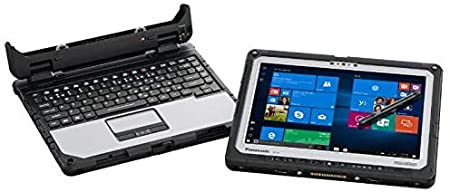It's reasonable to assume that the 2-in-1 model isn't just a passing fad or fashion in computing. It'll be around for a long time. Panasonic is proof of this, as the design was given to its Toughbook engineering department. The result is the Panasonic Toughbook CF-20, the company's first Toughbook featuring a tablet display that can be removed. We were fortunate enough to get our hands on one of the newest designs for a thorough examination.
Construct and Design
This isn't your average computer right out of the box. The Panasonic Toughbook CF 20 features a silver-toned magnesium alloy panel on top, as well as the now-signature design of Panasonic's fully robust Toughbook line: durable ABS plastic edges with bevelled corners all around. The Lenovo Yoga 710 weighs 3.9 pounds, which is a full pound more than comparable consumer products like the Dell Inspiron 11 3000. It is, however, 1.2 pounds lighter than the Toughbook 19.
According to the specifications, this device meets both the US Military's stringent durability criteria (MIL-STD-810G) and the IEC standards for dust and water resistance (IP65). As if that weren't enough, the Panasonic Toughbook CF-20 also meets military-grade electromagnetic compatibility criteria. But wait, there's more: the device also supports Class I Division 2 group ABCD compliance as an option. The Panasonic Toughbook CF-20 is one tough sucker with the paperwork to prove it, according to this alphabet soup of standards.
Tablet & Display
The Panasonic Toughbook CF-20 display is a 10.1-inch full HD display with a 16:10 aspect ratio and a native resolution of 1920 x 1200 pixels.
With a pixel-per-inch count of 224, such a high resolution on such a little panel results in an extremely sharp and clear image. This is just a smidgeon more than the 15-inch MacBook Pro's famed Retina display.
Panasonic Toughbook CF-20 promises an ultra-bright 800 nit display, which we found to be sufficient for its intended purpose of usage in direct sunlight. The touch screen supports ten-point multitouch and has the added benefit of being able to be used while wearing gloves.
Several buttons and indicator lights are located around the lower edge of the tablet's front. The first two buttons are customizable hot buttons, with the first being set to open a custom control panel with numerous option settings by default.
The volume up and down buttons are next, followed by the normal Windows home button and an auto-rotate lock button. The first battery, Wi-Fi connection, and charging status are all indicated via the three indicator lights. The power button is the last button on the row.
Audio & Ports
The Panasonic Toughbook CF-20 comes with an expansionist's dream set of ports, including some cleverly replicated ports. A VGA connector, a USB 2.0 slot, a full-size HDMI port, and a standard-size SD/XC memory card slot are all located on the right side of the keyboard dock. There's also a power outlet hidden behind a sturdy sealed door.
A good old-fashioned D-Sub 9-pin serial port can be found on the left side. This port, as old-school as it is, is practically necessary for the target market. This is the port that most specialist firmware-only computing devices utilize to connect to the computer.
Performance
According to the Panasonic website's configuration tool, the Panasonic Toughbook CF-20 is available in 592 different configurations. The majority of the differences, however, are due to the highly specialized attachments available, such as magstripe readers, specialist GPS modules, smartcard readers, and so on.
When it comes to the device's basic setups, the core is quite fixed. The Panasonic Toughbook CF-20 comes standard with an Intel CORE m5 processor (m5-6Y57) with dual cores running at 2.8GHz, 8GB of RAM, and a 128 or 256 GB SSD.
